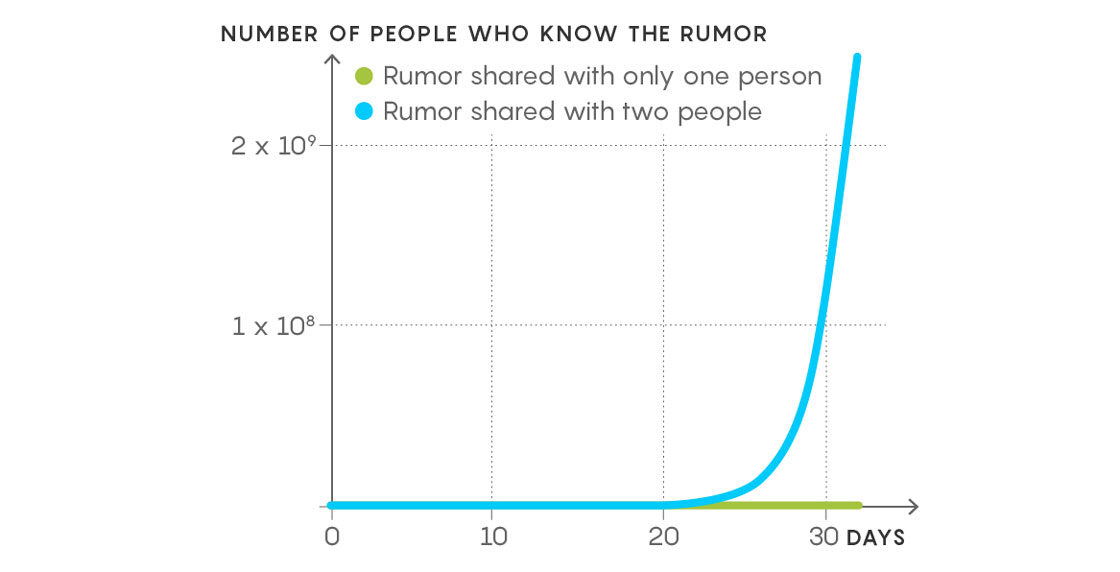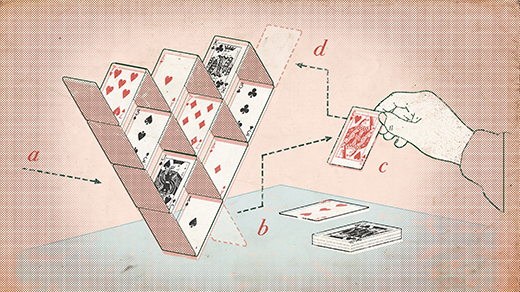How Math (and Vaccines) Keep You Safe From the Flu

BIG MOUTH for Quanta Magazine
Introduction
Let’s say you hear a juicy rumor that you just can’t keep to yourself. You hate rumormongers, so you compromise by telling only one person and then keeping your mouth shut. No big deal, right? After all, if the person you tell adopts the same policy and only tells one other person, the gossip won’t spread very far. If one new person hears the rumor each day, after 30 days it will have spread to only 31 people, including you.
So how bad could it be to tell two people? Shockingly bad, it turns out. If each day, each person who heard the rumor yesterday tells two new people, then after 30 days the rumor will have reached more than a quarter of the world’s population (2,147,483,647 people, or 231 − 1, to be exact). How can such a seemingly small change — telling two people instead of one — make such a big difference? The answer lies in rates of change.
In the first scenario, the rumor is transmitted each day to the same number of people who heard it yesterday. This will be true today, tomorrow, the next day, and so on, which means the number of new people hearing the rumor each day is constant. In our example, that number is one.
But if the rumor is transmitted each day to twice as many people as yesterday, the number of new rumor whisperers grows exponentially: Two new people hear the rumor on the first day, then four new people on the second day, eight new people on the third day, and so on. On the 30th day, a whopping 230 new people will hear the rumor (setting aside some reasonable objections that we’ll address later).
Why the enormous difference between scenarios one and two? It all has to do with linear versus exponential functions. Linear functions are characterized by a constant rate of change, like one new person hearing the rumor per day. Linear growth is slow and steady, the same constant increase each time. Exponential functions, on the other hand, are characterized by rates of change that increase multiplicatively: two new people hearing the rumor, then four new people, then eight, then 16, and so on. Unlike linear growth, exponential growth accelerates — the amount of increase itself continues to increase.
That’s the difference between 31 people hearing the rumor after 30 days, and 2 billion hearing it. And this is all simply a consequence of whether each person who hears the rumor spreads it to one person or to two.

This graph shows the number of people who know the rumor each day. The linear function, in green, appears almost horizontal, while the exponential function, in blue, extends vertically beyond 2 billion.
This elementary mathematical model captures the essence of a particular kind of reproduction that affects far more than the spreading of rumors. Like all elementary models, it ignores or simplifies many complicating factors — such as the likelihood of transmission and the size of the overall population — but it’s a great place to start exploring how ideas are disseminated, how populations grow and, as it turns out, how diseases spread.
Infections are spread in much the same way as a rumor: Someone picks it up and passes it on to someone else. There are differences, of course, but the same elementary mathematical model is useful in both situations. In our simple examples involving rumors, we saw how a seemingly small difference in the transmission rate of the rumor made a big difference in how many people ultimately heard it. The same is true when it comes to infectious diseases: the difference between passing the infection on to one person and passing it on to two can be the difference between a few isolated cases and an epidemic.
Every kind of communicable infection spreads in a community at a rate dependent on a unique set of biological, environmental and social factors. Epidemiologists try to summarize the impact of all of these factors in the infection’s “basic reproduction number.” This is the average number of new infections each infected person is expected to produce, and it is denoted R0. In the context of our rumor examples above, the basic reproduction numbers were R0 = 1 (each person spreading the rumor to exactly one other person) and R0 = 2 (each person spreading the rumor to exactly two other people); the “infectious period” was one day.
Here are some basic reproduction numbers for some well-known diseases.
| Disease | $latex R_0$ |
| Measles | 12-18 |
| Smallpox | 5-7 |
| Mumps | 4-7 |
| Influenza (1918 pandemic strain) | 2-3 |
Source: CDC and NIH
Notice that the basic reproduction numbers for these diseases are all greater than one. This is, in part, what makes them so dangerous: Since each infected person will, on average, infect more than one other person, the number of people infected with the disease will grow exponentially. This could have a devastating impact on a population. But given a basic reproduction number representing exponential growth, is it possible to make it linear? Can we lower a disease’s R0 to one?
Here’s where vaccination comes in. When vaccinated, an individual develops resistance to the disease: Success rates vary, but for simplicity we will assume that vaccination provides complete immunity to the disease. Vaccination directly benefits the vaccinated individual, but it also indirectly benefits the broader population. If many people in a community are vaccinated against a disease, the disease won’t spread as rapidly.
In effect, widespread vaccination can help reduce the effective reproduction number of the disease. And if enough individuals are vaccinated, the effective reproduction number can actually be reduced to one, ensuring that the disease will only spread at a linear rate. So how many individuals need to be vaccinated to bring a disease’s effective reproduction number down to one?
Let’s think about what the basic reproduction number really tells us. Consider an influenza epidemic with R0 = 2. This means that an infected person will, on average, infect two new people. This single number, R0 = 2, offers us a lot of information: how easily the disease is transmitted, the length of the infectious period, and the average number of people an infected person will interact with in a given period of time. By unpacking this number, we can easily see how vaccination can reduce it.
Let’s assume that a person infected with a flu virus with R0 = 2 will encounter 10 other people while infected. We can picture this as a diagram, with the infected person in green at the center and the arrows leading out to each of the 10 people encountered.

Everyone contacted has a chance of catching the flu, but the fact that R0 = 2 means that, on average, two of these 10 people will contract the disease.

Generally speaking, we can then say that each person has a 2/10, or 20 percent, chance of contracting the disease.
But suppose that two of these 10 people have been vaccinated for influenza. Assuming, again for simplicity, that vaccination provides complete immunity, this means the infection cannot be transmitted to them. But each of the remaining eight people still has a 20 percent chance of being infected. This means, on average, 0.2 × 8 of the 10 people, or 1.6, will be infected.
So if two out of every 10 people are vaccinated, then one infected person will only infect, on average, 1.6 people. The vaccination has effectively reduced the basic reproduction number for this disease from R0 = 2 to R0 = 1.6. So how do we get the basic reproduction number down to one to avoid exponential growth?
Again, we assume that our initial infected person comes into contact with 10 people during the infectious period, and that each unvaccinated person has a 20 percent chance of being infected. Now, suppose a number V of those 10 people are vaccinated. We would expect that, on average, 20 percent of the 10 − V unvaccinated individuals, or 0.2 × (10 − V), will become infected. For growth to be linear and not exponential, we need the average number of new infections to be one. Thus, we need to solve the equation: 0.2 × (10 − V) = 1.
A little algebraic manipulation shows us that V = 5 satisfies this equation. So let’s see what happens when five of the 10 contacted people are vaccinated; we’ll color them blue in our diagram below.

Vaccination essentially removes those five individuals from the diagram, because the disease cannot be transmitted to them.
Now each of the remaining five individuals still has a 20 percent chance of becoming infected, so on average one of them will contract the disease. This means that of the original 10 people contacted, only one is infected: Thus, by vaccinating five out of every 10 people, we’ve effectively reduced this disease’s R0 to one.

This process can be generalized for any basic reproduction number R0. If we assume that each infected person contacts N new people per infectious period, then we can expect, on average, R0/N of those people to become infected. But if V is the number of vaccinated individuals among the N contacted, then
$latex \frac {R_0}{N}( N – V )$
represents the number of new infections. We want this to equal one, so we have the equation:
$latex \frac {R_0}{N}( N – V ) = 1$
It makes sense to solve for V/N, which represents the total percentage of vaccinated individuals in the population, as V out of every N people are vaccinated. A little more algebraic manipulation gives us
$latex \frac {V}{N}= 1 – \frac {1}{R_0}$
This means that if the percentage of vaccinated individuals among the general population is 1 − 1/R0, then, on average, each infected person will infect just one new person. Thus, 1 − 1/R0 is the magic percentage that results in linear, and not exponential, growth of the disease.
At this level of vaccination — namely, 1 − 1/R0 percent of the entire population — a group achieves a kind of collective immunity to a disease: not immunity from individuals becoming infected, but immunity from the disease spreading through the population at an exponential rate. This property is known as “herd immunity.” The percentage of vaccination required in a population to achieve herd immunity is referred to as the “herd immunity threshold” (HIT). Here are some examples of HITs for various diseases.
| Disease | R0 | $latex 1 – \frac {1}{R_0}$ | HIT |
| Measles | 12 | $latex 1 – \frac {1}{12}$ | 91.7% |
| Smallpox | 5 | $latex 1 – \frac {1}{5}$ | 80% |
| Mumps | 4 | $latex 1 – \frac {1}{4}$ | 75% |
| Influenza pandemic | 2 | $latex 1 – \frac {1}{2}$ | 50% |
Clearly, vaccination against a disease provides a potential benefit not only to the vaccinated individual, but to the community as well. When the threshold for herd immunity is reached, the rate at which the disease can spread through a population is kept low enough to avoid potential catastrophe. Widespread vaccination turns a diagram like the one on the left, with many potential paths for the disease to spread throughout a population, into something more like the one on the right, where fewer paths result in slower growth and reduced chances of an epidemic outbreak.

One important feature of herd immunity is that it benefits even the unvaccinated individuals in a population. Since the disease is less likely to spread widely, everyone is at lower risk — including those who are unvaccinated. This is especially important for individuals for whom vaccination can sometimes be medically ill-advised, like infants, the elderly and the infirm. And although we’ve assumed here that vaccinations are 100 percent effective, the benefits of herd immunity can be achieved even when they aren’t: Even at less than 100 percent effectiveness, widespread vaccination still reduces the average number of new infections per infected person, thereby lowering the disease’s effective reproduction number.
We’ve seen the dramatic difference between linear and exponential growth. When it comes to disease transmission, it can literally be a matter of life or death. The mathematics underlying vaccinations and herd immunity is important, so tell a friend. Better yet, tell two.
Download the “Math of Herd Immunity” PDF worksheet to share with students.
This article was reprinted in Spanish at Investigacionyciencia.es.



